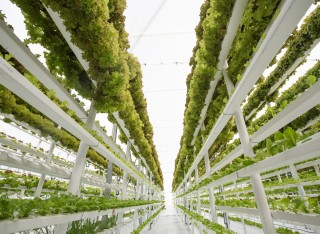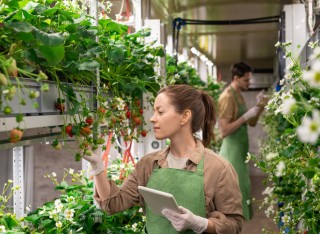
Michael Gargaro
Academic and research departments
Centre for Environment and Sustainability, School of Sustainability, Civil and Environmental Engineering.About
My research project
The land sparing potential of vertical farming to support Bioenergy with Carbon Capture Storage (BECCS) deploymentThis PhD will assess the land substitution potential of vertical farming (VF) technologies at a global scale. The project will explore which crops are currently commercially viable in VF and how field grown crops can be moved into VF production around the world. Spatial, technical and socio-economic modelling will be used to assess the transition from field-based agriculture into VF. In collaboration with the University of Aberdeen, the potential to grow bioenergy crops in these areas where land has been ‘spared’, will be assessed.
Supervisors
This PhD will assess the land substitution potential of vertical farming (VF) technologies at a global scale. The project will explore which crops are currently commercially viable in VF and how field grown crops can be moved into VF production around the world. Spatial, technical and socio-economic modelling will be used to assess the transition from field-based agriculture into VF. In collaboration with the University of Aberdeen, the potential to grow bioenergy crops in these areas where land has been ‘spared’, will be assessed.
Publications
Climate change has accelerated the degradation of agricultural land, prompting innovation to develop and adapt current global production systems to accommodate more people with increased demand for resources. Novel technologies such as vertical farming offer an opportunity to secure climate-resilient food production. This study used Life Cycle Assessment to examine how the environmental impact of lettuce production in a commercial vertical farm compares with traditional field farming based on two contrasting UK farms and a Spanish farm. The vertical farm was found to have higher emissions in all impact categories except for water use; however, when using renewable energy sources, vertical farming was found to have higher, yet more comparable greenhouse gas emissions to field farming (0.93 kg CO2eq kg-1 lettuce (VF), 0.58 kg CO2eq kg-1 lettuce (UK 1 + 2)). Energy use (electricity or diesel), the choice of substrate, and soil emissions were the biggest hotspots for lettuce production in this study. Yields per area in vertical farming systems, however, were much higher than the field farming scenarios (97.3 kg m-2 (VF), 3.3 kg m-2 (average of field farms)), and the land sparing potential of vertical farming systems offers an opportunity to use spared land to potentially reap other environmental benefits while securing food production.
Global population rise, increased rural to urban migration, climate change and conflict have placed strain on global trade and food supply chains. Vertical farming (VF) is a relatively novel method for cultivating many fresh fruits and vegetables, and often is claimed to have lower environmental impacts than field cultivation. However, to date there are few studies utilising primary data which have evaluated the environmental impact VF may have. This study utilised Life Cycle Assessment (LCA) to evaluate the environmental impact of lettuce production in a commercial vertical farm in the UK. This was compared with data from the literature on the impacts of lettuce in field cultivation. Scenarios were also examined to evaluate the impact of VF systems with varying electricity sources, and waste, water and nutrient management options. The VF was found to have a similar or lower Climate Change impact than field cultivation, depending on energy source used. VF had a slightly higher environmental impact than field cultivation in some other environmental impact categories such as freshwater eutrophication potential and acidification potential. Electricity demand and the medium used for ‘plugs’ in the VF were found to be the main hotspots of the system. The results of this study provide insights on the environmental impact and resource efficiency of VF, feasibility for larger scale deployment, and provide further empirical evidence to support the claims made previously in the literature. [Display omitted] •An LCA of a commercial vertical farm in the UK using primary production data.•System hotspots were electricity requirements and cultivation substrate used.•Climate Change impacts reduced 6-fold by using renewable energy electricity.•Overall emissions profile is comparable to field-based lettuce cultivation.•Vertical farming systems offer substantial land sparing potential.
Climate change-related impacts have hampered the productivity of agricultural lands in recent times, affecting food security globally. Novel technology-based agricultural production systems such as controlled-environment agriculture (CEA) are a way to reduce the impact of climatic variation and pests that harm current global crop production and ensure consistent crop development. These systems often use artificial lighting and soilless mediums to produce crops. This meta-analysis has investigated the key influencing factors on crop production within these systems, using previous studies on lettuce (the most cultivated crop in these systems) to understand what affects yield within CEA. This analysis has found that on average, CEA systems yield twice that of field-based agriculture (3.68 kg m −2 vs. 1.88 kg m −2), with the most influencing factors being the variety of cultivars grown, the season, the nutrient delivery method, and the lighting type. The cultivation time for this study was 40 days, with 94% of papers having trial periods of 70 days or less, much lower than field-based agriculture (60–120 days). Vertical farming (stacked vertical CEA cultivation) studies were found to especially drive up yield per area (6.88 kg m −2). The results of this meta-analysis are useful for starting to understand the key influencing factors on CEA growth and highlight the breadth of research ongoing in the CEA industry.

